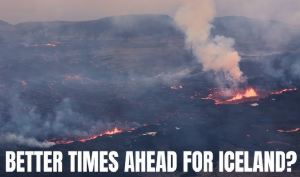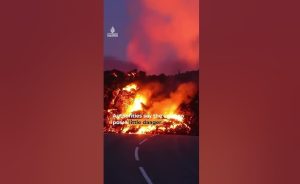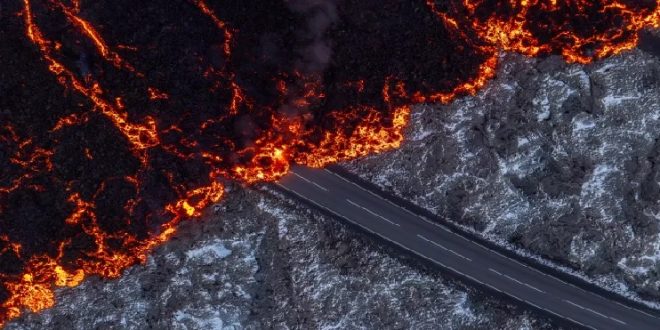24-11-2024
BLUE LAGOON, PENINSULA: A volcano on Iceland’s Reykjanes Peninsula erupted for the seventh time since December, sending plumes of smoke into the sky and bright orange lava flowing across the region.
The eruption, which began late Wednesday night with little warning, forced the evacuation of nearby Grindavik and the popular Blue Lagoon geothermal spa.
 The latest eruption, which marks the 10th in the region since 2021, occurred at approximately 11:14 p.m. local time, with the fissure created by the eruption stretching about 1.8 miles.
The latest eruption, which marks the 10th in the region since 2021, occurred at approximately 11:14 p.m. local time, with the fissure created by the eruption stretching about 1.8 miles.
While seismic activity had been minimal in the days prior, the eruption peaked early Thursday morning at around 2 am.
“Seismic activity did not start increasing in the weeks leading up to this eruption,” said the Icelandic Meteorological Office. “The first signs of eruption appeared only 45 minutes before it began.”
As of Thursday, no casualties have been reported. Authorities said there was no immediate danger to the region, though gas emissions from the eruption are expected to move southward, out to sea. Emergency officials confirmed that there were no disruptions to flights, though nearby roads were closed.
Magnus Tumi Gudmundsson, a geophysics professor at the University of Iceland, said lava from the eruption had reached the parking lot of the Blue Lagoon. “Barriers to protect Grindavik, the Blue Lagoon, and the nearby Svartsengi Power Plant have been effective so far,” Gudmundsson added. “There is no guarantee that they will hold, but with the lava flow slowing, the area is not at serious risk right now.”
The eruption is smaller than the previous one in August, but its timing and proximity to populated areas have raised concerns. The town of Grindavik, about 30 miles southwest of Reykjavik, was evacuated smoothly, with around 50-60 homes affected. Local authorities confirmed that residents were well-prepared for the evacuation, which was conducted without incident.
The Blue Lagoon, a major tourist attraction, was closed on Thursday. The spa, which sits near the site of the eruption, was temporarily evacuated as a precautionary measure. The Reykjanes Peninsula has been experiencing heightened volcanic activity since 2021, with several eruptions over the past few years. However, scientists  caution that predicting the full scope of future eruptions remains difficult. Gudmundsson noted that past volcanic activity in the region could lead to a period of relative calm lasting up to 150 years.
caution that predicting the full scope of future eruptions remains difficult. Gudmundsson noted that past volcanic activity in the region could lead to a period of relative calm lasting up to 150 years.
A volcano in southwestern Iceland has erupted for the sixth time since December, according to the country’s meteorological office.
The eruption started at 9:26pm (21:26 GMT) on Thursday, with live video images showing red lava spewing out of a new fissure on the Reykjanes Peninsula, the Icelandic Meteorological Office said.
The total length of the fissure was about 3.9km (2.4 miles) and had extended by 1.5km (0.93 miles) in about 40 minutes, said the met office in a statement.
Iceland’s Ministry for Foreign Affairs said the eruption did not “present a threat to life” and that the nearby area had been evacuated. “The impact is limited to a localized area near the eruption site,” it posted on social media platform X.
Regional police Chief Ulfar Ludviksson told Icelandic media that the evacuation of the nearby fishing village of Grindavik was going well, adding that 22 or 23 houses were currently occupied. Most of Grindavik’s 4,000 residents had evacuated in November, prior to an eruption in December, and while residents have since been allowed to return in between eruptions, only a few have opted to stay overnight. (Int’l Monitoring Desk)
 Pressmediaofindia
Pressmediaofindia




